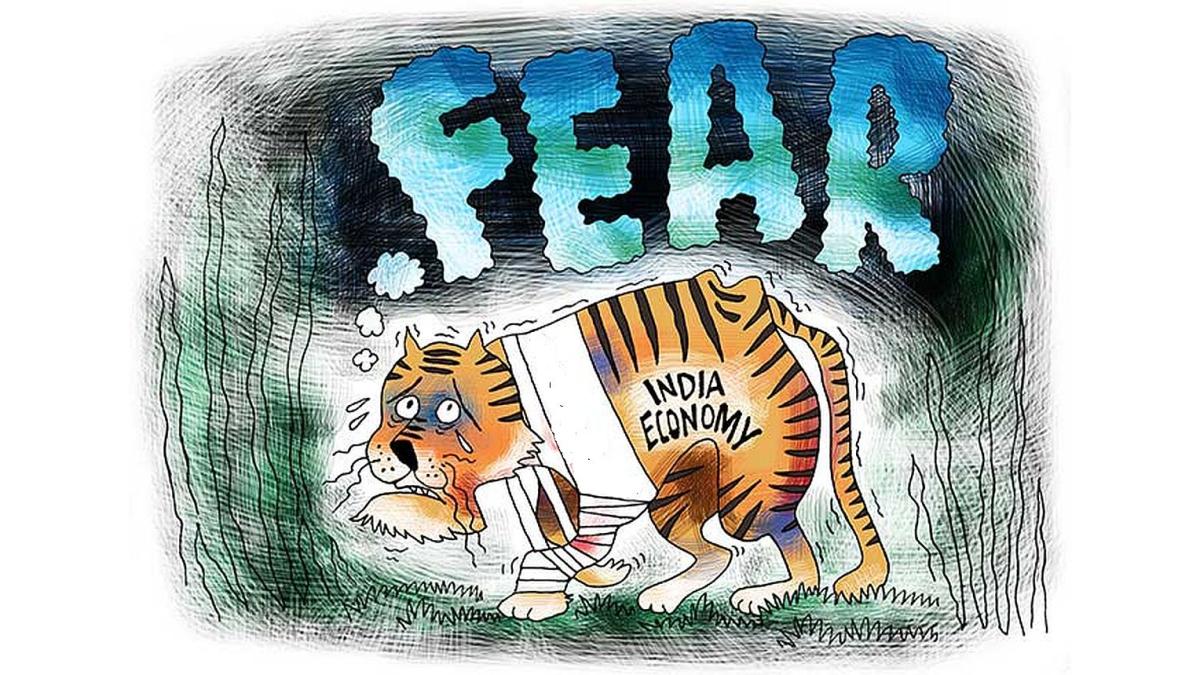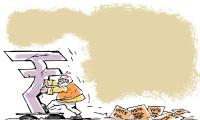Moody's Forecasts 7.2% Indian GDP Growth in 2024
Moody's says India's economy is in a 'sweet spot', forecasting 7.2% GDP growth in 2024 and 6.6% in 2025, driven by strong consumption and investment.

Illustration: Uttam Ghosh/Rediff.com
New Delhi, Nov 15 (PTI) Indian economy is in a sweet spot, with a mix of solid growth and moderating inflation, Moody's Ratings said, forecasting a 7.2 per cent GDP growth in the 2024 calendar year and 6.6 per cent in the next.
In its Global Macro Outlook 2025-26, the rating agency said the global economy has shown remarkable resilience in bouncing back from supply chain disruptions during the pandemic, an energy and food crisis after the Russia-Ukraine war began, high inflation and consequent monetary policy tightening.
"Most G-20 economies will experience steady growth and continue to benefit from policy easing and supportive commodity prices," it said.
However, post-election changes in US domestic and international policies could potentially accelerate global economic fragmentation, complicating ongoing stabilisation. The aggregate and net effects of trade, fiscal, immigration and regulatory policy changes will expand the range of outcomes for countries and sectors.
On India, Moody's said the real GDP expanded 6.7 per cent year-over-year in the second quarter (April-June) of 2024, driven by a revival in household consumption, robust investment and strong manufacturing activity.
High-frequency indicators including expanding manufacturing and services PMIs, robust credit growth and consumer optimism - signal steady economic momentum in Q3.
"Indeed, from a macroeconomic perspective, the Indian economy is in a sweet spot, with the mix of solid growth and moderating inflation. We forecast 7.2 per cent growth for calendar year 2024, followed by 6.6 per cent in 2025 and 6.5 per cent in 2026," it said.
Moody's said household consumption in India is poised to grow, fuelled by increased spending during the ongoing festive season and a sustained pickup in rural demand on the back of an improved agricultural outlook.
Additionally, rising capacity utilisation, upbeat business sentiment and the government's continued thrust on infrastructure spending should support private investment.
"Sound economic fundamentals, including healthy corporate and bank balance sheets, a stronger external position, and ample foreign exchange reserves also bode well for the growth outlook," it added.
Sporadic food price pressures continue to inject volatility in the disinflation trajectory.
Headline inflation breached the upper end of the RBI's 4 per cent (+/-2 per cent) tolerance band for the first time in more than a year in October, accelerating to 6.2 per cent amid a sharp jump in vegetable prices.
"Despite the near-term uptick, inflation should moderate toward the RBI's target in the coming months as food prices ease amid higher sowing and adequate food grain buffer stocks," the agency said.
Even so, potential risks to inflation from heightened geopolitical tensions and extreme weather events underscore the RBI's cautious approach to policy easing.
Although the central bank shifted its monetary policy stance to neutral while keeping the repo rate steady at 6.5 per cent in October, it will likely retain relatively tight monetary policy settings into next year, given the fairly healthy growth dynamics and inflation risks.
In its Global Macro Outlook 2025-26, the rating agency said the global economy has shown remarkable resilience in bouncing back from supply chain disruptions during the pandemic, an energy and food crisis after the Russia-Ukraine war began, high inflation and consequent monetary policy tightening.
"Most G-20 economies will experience steady growth and continue to benefit from policy easing and supportive commodity prices," it said.
However, post-election changes in US domestic and international policies could potentially accelerate global economic fragmentation, complicating ongoing stabilisation. The aggregate and net effects of trade, fiscal, immigration and regulatory policy changes will expand the range of outcomes for countries and sectors.
On India, Moody's said the real GDP expanded 6.7 per cent year-over-year in the second quarter (April-June) of 2024, driven by a revival in household consumption, robust investment and strong manufacturing activity.
High-frequency indicators including expanding manufacturing and services PMIs, robust credit growth and consumer optimism - signal steady economic momentum in Q3.
"Indeed, from a macroeconomic perspective, the Indian economy is in a sweet spot, with the mix of solid growth and moderating inflation. We forecast 7.2 per cent growth for calendar year 2024, followed by 6.6 per cent in 2025 and 6.5 per cent in 2026," it said.
Moody's said household consumption in India is poised to grow, fuelled by increased spending during the ongoing festive season and a sustained pickup in rural demand on the back of an improved agricultural outlook.
Additionally, rising capacity utilisation, upbeat business sentiment and the government's continued thrust on infrastructure spending should support private investment.
"Sound economic fundamentals, including healthy corporate and bank balance sheets, a stronger external position, and ample foreign exchange reserves also bode well for the growth outlook," it added.
Sporadic food price pressures continue to inject volatility in the disinflation trajectory.
Headline inflation breached the upper end of the RBI's 4 per cent (+/-2 per cent) tolerance band for the first time in more than a year in October, accelerating to 6.2 per cent amid a sharp jump in vegetable prices.
"Despite the near-term uptick, inflation should moderate toward the RBI's target in the coming months as food prices ease amid higher sowing and adequate food grain buffer stocks," the agency said.
Even so, potential risks to inflation from heightened geopolitical tensions and extreme weather events underscore the RBI's cautious approach to policy easing.
Although the central bank shifted its monetary policy stance to neutral while keeping the repo rate steady at 6.5 per cent in October, it will likely retain relatively tight monetary policy settings into next year, given the fairly healthy growth dynamics and inflation risks.
You May Like To Read
TODAY'S MOST TRADED COMPANIES
- Company Name
- Price
- Volume
- Vodafone-Idea-L
- 11.65 (+ 3.56)
- 106772451
- Alstone-Textiles
- 0.28 ( -3.45)
- 44187760
- Mangalam-Industrial
- 0.88 ( -2.22)
- 39177573
- Sunshine-Capital
- 0.27 (+ 3.85)
- 35956340
- GMR-Airports
- 104.40 (+ 6.37)
- 30453005





